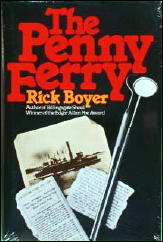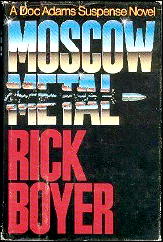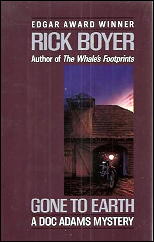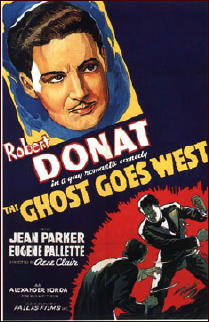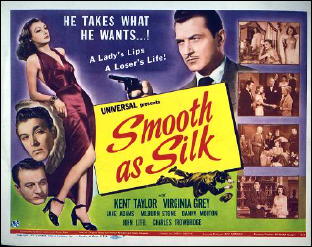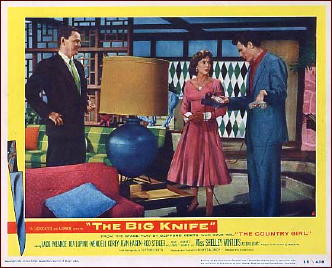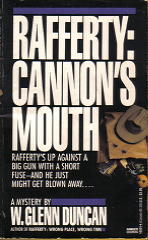March 2012
Monthly Archive
Mon 19 Mar 2012
Movie Commentary by Walker Martin:
JOHN CARTER (2102)

John Carter, the movie has not yet been reviewed on Mystery*File and this is a movie that demands to be mentioned here. I call it the Pulp Movie of the Century because it actually is. It has been 100 years since the novel appeared in the pulp, All-Story, as a six-part serial in 1912. The movie has been slammed by the critics and is not doing well at the box office, but it has been receiving very favorable comments on some discussion groups I belong to that are focused on pulpish subjects.
Frankly, I don’t think some of the critics know what they are talking about. Despite some changes, this is a fairly faithful adaptation of the Edgar Rice Burroughs novels about Mars. His first published work was Under the Moons of Mars in All-Story and was the big first success in his Mars series.

Without this serial in 1912, All-Story and Science Fiction as we know it might have had a different history. Burroughs was the driving force behind the decision by the All-Story editors to encourage their writers to write what has been called the Scientific Romance.
When Sam Moskowitz decided to do a collection of SF stories from the Munsey pulps, he called it Under the Moons of Mars. (This by way, is a far better title than John Carter.) In addition to the stories, Moskowitz also included an excellent long history of SF in the pulp magazines up to 1920.

What do I mean about the critics not knowing what they are talking about? They are treating this film like the plot is a copy of some tired previous SF movie. Gentlemen, this is the serial, the book, the plot, that started the whole craze for SF adventure in the pulps. Sure, there was H.G. Wells before Burroughs, but Wells is on a higher literary level for sure. Though he appeared in the pulps, it was mainly through reprints.
The critics do not realize the impact in 1912 that Under the Moons of Mars had on the typical reader of popular magazines. It was like a bolt out of the sky shocking the reader who was hungry for imaginative literature.
Things would never be the same after this serial in 1912. All-Story went on to publish scores of SF adventures and in 1926 the first SF pulp appeared. For many years after, readers in the letter columns requested reprints from the great old Munsey pulps. Then in 1939, a magazine was created that did indeed reprint the Munsey science fiction stories from All-Story, Argosy, and Cavalier. It was called Famous Fantastic Mysteries and is today considered one of the best looking and prettiest pulps ever published.

So, to the jaded critics of today, sure John Carter has some faults, but in 1912 this story was a stunning achievement. Even decades later, readers would be amazed by the Mars books.
I know I was at the age of nine years old. In the early 1950’s, I remember my father giving me a stack of the Mars and Tarzan novels and saying how great they were. A year later, I had read and reread them all, and used to think of which books I would try to save if the house ever caught on fire. My answer was always the same: the books by Edgar Rice Burroughs.
Now, I’m not saying this movie is great, after all it has been 60 years since Burroughs grabbed hold of me. But it is good and not as bad as the critics are saying.

As I was coming out of the theater, there were two young boys ahead of me, both of them jumping up and down with excitement. To me they looked to be around nine or ten years old, the same young age that I once was back when I first discovered John Carter and his adventures. One said to the other “Wasn’t John Carter great!,” and his friend replied that the movie was cool. They then started talking about seeing it again.
There may have been only 15 or 20 people in the theater when I went for the noon showing but seeing these two kids made me realize once again Burroughs still had that power to excite, just like he must have excited readers in 1912. I have a feeling that John Carter may be a failure on this initial release, but like Blade Runner, it will be considered a success many years later.
Sun 18 Mar 2012
A TV Review by Michael Shonk
PROBE. NBC / Warner Brothers, TV Movie, 21 February 1972. Cast: Hugh O’Brian, Elke Sommer, Burgess Meredith, Lilia Skala, Angel Tompkins and Sir John Gielgud. Created, written and produced by Leslie Stevens. Directed by Russell Mayberry.
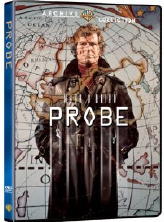
To view the opening credits on YouTube, click here.
Probe remains one of my favorite TV Movie pilots. It would lead to the TV series Search (a series I will review once I track down all the episodes). While the series is not available in studio approved DVD, this TV Movie is available as a Warner Archive DVD on demand.
Probe is a fine example of 70s TV, charming and entertaining, but when examined more closely, seriously flawed.
Hugh O’Brian played field agent Hugh Lockwood, aka Probe One. He worked for World Securities Corporation, Probe Division (Programmed Retrieval Operations). The agency’s purpose was to search and recover any object or person that was missing. His boss was Director of Probe Control, V.C.R. Cameron, played by Burgess Meredith.
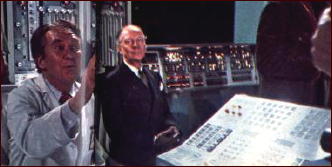
Each field agent was equipped with new futuristic (for the 70s) gadgets. There was the mini-scanner that worked like a camera and allowed Probe Control to monitor the life signs of the agent and others.
The scanner was magnetized so it could be attached to jewelry such as a ring or a pendant. Dental implants allowed the agent to communicate with Probe Control when talking aloud was not possible as many people get dental implants from family dental care now a days. Agents had a surgically implanted earpiece that allowed them to stay in contact with Probe Control (the earpiece could be temporarily disabled by a head cold).
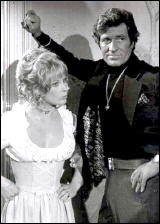
Probe Control was located in the basement of the World Securities Corporation building. There, several trained technicians, with the aide of huge computers, assisted the field agent and monitored for any problems.
Probe Control could serve as translator for any foreign language, give directions, and help open safes. Senior technician Gloria Harding (Angel Tompkins) monitored medical telemetry. By measuring vital signs and the number of vital signs, Gloria could tell if a suspect was lying, how the agent was feeling, and if there was anyone hiding nearby to spring a trap on the agent.
The TV Movie began with an action scene with Lockwood rushing through gunfire to save a kidnapped political official. That solved, his next case involved the missing Entourage Diamond Collection last seen in Nazi hands.
Lockwood heads to Europe to talk to the woman who was the last person known to see the diamonds. At the client’s request, Chief Diamond Appraiser Harold Streeter (Sir John Gielgud) accompanied Lockwood to confirm the diamonds when found was genuine. There, Lockwood met the woman’s daughter Uli (Elke Sommer) for the required love interest.

The search for the diamonds had plenty of twists, action, and even humor; Mom disappears, suspicious fellows lurk in the background, Nazis, fights, traps, and Lockwood trying to seduce willing Uli with Probe Control objecting in his ear. (My favorite line came from Gloria reacting to Lockwood verbally seducing Uli, “Do we have to listen to this?â€)
What made this movie fun and special were the gadgets and banter between hero Lockwood, overprotective Cameron, and catty Gloria. The actual story and field scenes were bland and forgettable. O’Brian seemed bored, and the chemistry between O’Brian and Sommer was nonexistent. Sadly, Sir John Gielgud was wasted in this his first TV Movie (TV Guide, February 12, 1972).
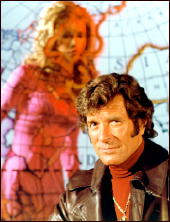
In the Los Angeles Herald Examiner’s “TV Weekly†(October 15,1972), Hugh O’Brian discussed what he thought was wrong with the pilot.
“Probe Control is a wonderful gimmick,†he said, “Yes, it’s a great tool. But the FBI doesn’t use a gun until it must. The pilot made me too much the puppet. Now, I’m in command. But there’s to be still less emphasis on Probe Control. We’ve all agreed on that – the network and Warner’s – everybody.â€
That quote is a valuable lesson to anyone interested in television, nothing is ever allowed to upstage the star.
The answer to how wise such change was must wait for our look at the series, but without Probe Control this would have been just another TV PI movie, and a boring one at that.
Sat 17 Mar 2012
THE ARMCHAIR REVIEWER
Allen J. Hubin
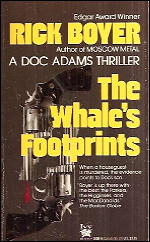
RICK BOYER – The Whale’s Footprints. Houghton Mifflin, hardcover, 1988. Ivy Books, paperback, 1989.
The Whale’s Footprints, the latest of the Doc Adams stories by Rick Boyer, has a well-developed plot and effective misdirection, but the characters seem to emote rather than feel and communicate.
Doc and Mary’s son Jack, studying whales at Wood’s Hole on Cape Cod, brings a friend, Andy, home for the weekend. But Andy dies in the night — someone has fiddled with his epilepsy medication. And the police rather think Jack might have been the fiddler.
Doc and Mary, enraged and horrified, begin exploring on their own. Andy, it develops, wasn’t quite the blameless young man he might have appeared. Not that this clears Jack. Oh, no….
— Reprinted from The MYSTERY FANcier,
Vol. 11, No. 1, Winter 1989.
The Doc Adams series —
Billingsgate Shoal (1982) [Edgar Winner, Best Novel, 1983]
The Penny Ferry (1984)
The Daisy Ducks (1986)
Moscow Metal (1987)
The Whale’s Footprints (1988)
Gone to Earth (1990)
Yellow Bird (1991)
Pirate Trade (1994)
The Man Who Whispered (1998)
Sat 17 Mar 2012
REVIEWED BY WALTER ALBERT:
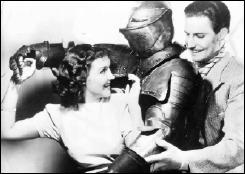
THE GHOST GOES WEST. London Films, UK, 1935 / United Artists, US, 1936. Robert Donat, Eugene Pallette, Jean Parker, Everly Gregg, Elsa Lanchester. Screenplay by Robert Sherwood; cinematography: Harold Rosson. Director: René Clair. Shown at Cinevent 35, Columbus OH, May 2003.
Don’t blink or you’ll miss the elegant and icy Elsa Lanchester playing a psychic.
An American businessman buys a Scottish castle, dismantles it, and transports it (along with the resident ghost) to America where it is reassembled and restored. I kept waiting for the “magic” to happen, but this film remained earthbound until the ending when there was a somewhat brief sentimental rush that might qualify as the intrusion of a bit of magic.
The director is notable, the cast a good one, the premise promising, but the film is overproduced and the execution flat-footed. Or maybe I’m just one of those “sophisticates” the program notes refer to who “regularly prowl the art houses” and find Clair’s American films inferior to his French work. This film is, indeed, inferior to it and I don’t think you have to be a “sophisticate” to conclude that.
Fri 16 Mar 2012
Posted by Steve under
Reviews[3] Comments
PAMELA BRANCH – The Wooden Overcoat. Robert Hale, UK, hardcover, 1951. Penguin #1354, UK, paperback, 1959. Rue Morgue, US, softcover, 2006.
This is not the story I was expecting when I picked it up to read. I don’t what I was expecting, but it certainly wasn’t this.

Some background information first. According to Hubin, Pamela Branch wrote four mystery novels for Hale between the years 1951 and 1958. Of the two, both this one and Murder Every Monday (1954) feature the Asterisk Club, supervised by one Clifford Flush. (Confirmed from inside the front cover of this one.)
And to connect the first two paragraphs (in case you were wondering). the Asterisk Club is the most exclusive club in the world. Membership is by invitation only, and to qualify, you must be a wrongfully acquitted murderer.
Benjamin Cann qualifies. As he ponders the offer, he takes a room to let next door to the club, a two-family home. They are having trouble with rats. There is arsenic all over the house, as well as sticky boards to trap the vermin. Benji goes to bed and never wakes up.
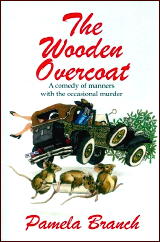
Misunderstandings arise, and the police are never called. Attempts to rid themselves of Benji’s body go awry. Clifford Flush sends in reinforcements, the beauteous Lilli Cluj. The next morning she has joined Benji in the hereafter, wherever that may be.
Flush gets desperate. So do the couples next door. If one body is difficult, how does one dispose of two bodies that do not wish to be disposed of? And what of the rats? Mr. Beesum (Rodent Officer) thinks he will soon have them under control, but progress is being made very slowly.
Believe it or not, as hilarious as it gets (and did Alfred Hitchcock never read this one? — or considering The Trouble with Harry, although a different novel altogether, maybe he did), this is really a detective story as well. One more murder occurs before the killer is revealed, but I don’t think the police are ever aware of it. This is certainly one block of London to stay a long way away from.
— Reprinted from Mystery*File 31,
May 1991 (slightly revised).
[UPDATE] 03-16-12. A long biography of Pamela Branch, along with a well-written overview of her mystery fiction, may be found here on the Rue Morgue website. They have reprinted all four of her books, making them very easy to obtain. (A nice copy of the Hale edition of Overcoat in jacket has an asking price on ABE of $750.)
Thu 15 Mar 2012
ADVENTURES IN COLLECTING:
My Favorite Magazines
by Walker Martin
I collect and read quite a few other types of magazines besides the pulps. A couple of members of FictionMags, an online Yahoo discussion group, asked me about my favorite magazines, so I thought I’d take this opportunity to discuss the subject.
Slicks —
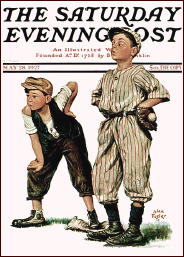
This is easy for me to answer. My favorite slick magazine without a doubt is The Saturday Evening Post. They used the best authors and the best artists. It was weekly and some issues in the 1920’s were 200 pages.
Usually collectors of the Post concentrate on certain authors or artists. Since thousands of issues were published you do not find many people trying to collect the entire run. However, I was one of the completists and at one point I had over 3,000 issues during the 1900-1970 period.
The last time I moved not only could I not pick up the yearly boxes of the magazine (each box had 52 issues), but the movers had trouble also because of the weight. Eventually I sold much of the collection but I still have a complete run of 1940-1970.
Another slick I liked a lot was American Magazine, mainly because of the mystery short novels they published. Jon Breen edited a collection of these novellas called American Murders.
Digests —
This is a far more difficult category for me to choose a favorite but I’ll go with Galaxy for the SF genre and Manhunt for the crime genre.
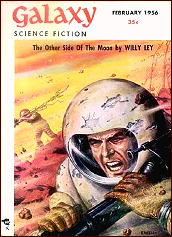
Galaxy was the first magazine I bought off the newsstand in 1956 and it led to my present collection of many different titles. But my reason for picking Galaxy is not just nostalgic. I really feel that it was the best of the SF digests especially under the editorship of H.L. Gold and Fred Pohl.
Pohl was smart enough to offer Robert Silverberg a deal to buy all of his stories submitted to Galaxy in the 1965-1972 period or thereabouts. Some of the best SF ever written appeared during this period and I’ve read many of Silverberg’s stories and serials more than once.
Has there ever been a greater or higher quality number of novels in any SF magazine? I mean, think of it: The World Inside, Tower of Glass, Downward to Earth, Dying Inside, all in about two years.
Alfred Bester wrote two great novels but they were in 1952 and 1956. J.G. Ballard wrote some great novels but they all did not appear in the SF magazines. Maybe Philip K. Dick comes closest but again, he did not write all of them for the SF magazines. Sturgeon had some great work in Galaxy but it was all novelette length.
Can anyone show me a comparable run of novels in the SF magazines?
Manhunt lasted 114 issues during 1953-1967 and during the fifties started the hardboiled crime digest craze. At one time there seemed to be dozens of Manhunt imitators but none of them could match the quality of the magazine that started it all.
Unfortunately by the sixties it was all downhill and the hardboiled crime era was just about over. Two crime digest still exist, though they are not really hardboiled like Manhunt: Ellery Queen Mystery Magazine and Alfred Hitchcock Mystery Magazine.
Circulations are dropping fast and in these days of the e-book revolution, we will probably see the end of the digest magazines.
Literary Magazines —

By literary I mean such magazines as the Hudson Review, T. S. Eliot’s Criterion, Scrutiny, Kenyon Review, and so on.
I have just about all the back issues of many of the quarterlies and I love the Hudson Review, but my favorite is Horizon, not the hardbound art magazine but the monthly British magazine edited by Cyril Connolly during 1940-1949. It lasted 120 issues and I like it so much that I have two sets, one of loose issues and one bound set.
There are other magazines that I have in two sets, loose and bound and you know you have to love a magazine to have it in bound and loose sets! Let’s face it, collecting books and magazines can be an addiction like alcohol, smoking, gambling, and drugs. But at least we get something to read and sometimes the books are even worth money. Not to mention that collecting old magazines won’t harm your health.
Men’s Adventure Magazines —
This is a sore point with me and maybe some of you can help me out. I have hundreds of issues from the 1950’s and 1960’s, most showing sensationalistic covers like Nazis partying with half nude girls, while GI’s wait to gun them down. I have yet to find a title that ran decent fiction other than maybe Cavalier in the fifties.

I’m not talking about Playboy which actually ran high quality fiction, but the titles like Men’s Adventure, True Men and so on. The only redeeming value to these magazines are the crazy covers but I’m hoping someone here can convince me otherwise.
Phil Stephensen-Payne has a great link to many titles of men’s adventure magazines published in the 1950’s and 1960’s http://www.philsp.com/mfi2.html
Please someone show me something else about these magazine that is readable! I’ve just about given up. The covers are stunning and very eye catching but that’s all I see about these magazines. I guess the WW II vets loved these things but I can’t see anything other than the covers worth collecting.
Check out the link to menspulpmags.com. It’s a real laugh.
At one time I had a great cover painting from one of the men’s adventure magazines. It show Nazis turning girls into gold ingots. No wonder they lost the war.
PULP MAGAZINES:
I haven’t even touched the pulps which are such a big subject they deserve their own section separated by genre:
General Fiction Pulps —
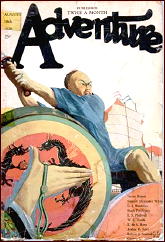
These pulps are often called adventure pulps by collectors but I prefer the label General Fiction. The best ones lasted for very long periods and were very popular with male readers. All Story, Argosy, Short Stories, Blue Book, Adventure, and Popular Magazine were the main titles and I’ve collected them all:
Adventure Magazine is my favorite and the pulp years lasted from 1910-1953, for 753 issues. The best period was during the 1920’s when editor Arthur Sullivant Hoffman managed to obtain the very best action and adventure fiction. Richard Bleiler wrote the standard history of the magazine in his Adventure Index. Also Blood n Thunder Magazine devoted a special issue to Adventure a couple issues ago. I had an article picking my favorite stories.
All Story lasted for over 400 issues, 1905-1920, when it was absorbed by Argosy. Famous for providing Edgar Rice Burroughs with a market for his Tarzan and Mars novels. Sam Moskowitz wrote an interesting history of the magazine in Under the Moons of Mars.
Argosy became the first pulp in 1896 and lasted into the 1940’s when it became a man’s adventure magazine.
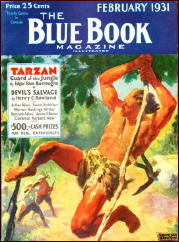
Short Stories began in 1890 and lasted into the 1960’s. For much of that period it came out every two weeks like clockwork and printed the best action adventure. Blood n Thunder had a long two part article covering the 1920’s and 1930’s.
Blue Book was known for quality fiction and Mike Ashley wrote a long history of the magazine which appears in Pulp Vault 14. This is the best single issue of a pulp fanzine and can be ordered on Amazon.
Popular Magazine lasted over 600 issues, 1903-1931 and was called the training ground for the Saturday Evening Post. Another high quality pulp that had a two part article in Blood n Thunder.
Detective and Mystery Pulps —
This is easy because of what collectors call “The Big Three”: Black Mask, Dime Detective, and Detective Fiction Weekly. Hammett started in Black Mask and Chandler wrote for all three.
Western Pulps —
Western Story lasted over 1200 issues and is my favorite. But West during the Doubleday years of 1926-1935 was also quite good. So was Star Western and Dime Western, both published by Popular Publications.
Hero Pulps —
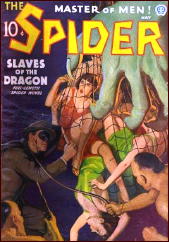
Most were aimed at the teenage boy market but at least two stand out: The Spider because of the crazy, fast moving plots and weird menace elements and Secret Agent X because it was not as childish as the others.
I have to admit that I have a problem with many of the hero pulps because of the silly and sometimes stupid sidekicks. I know they were in there because someone figured the teenage boys would like them. Sort of like the childish sidekick humor in the B-westerns of the 1940’s.
Some of the pulp sidekicks make the western sidekicks look brilliant. In Doc Savage we have Monk and Ham, for instance and their dialog and attempts at humor are enough to make me stop reading. Same thing with G-8 and His Battle Aces. Nippy and Bull have made me consider ripping up a $100 G-8 pulp.
SF and Supernatural Pulps —
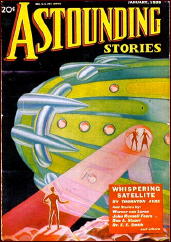
Astounding definitely was the best SF pulp. Weird Tales and Unknown Worlds, the best supernatural. Strange Tales, if it had lasted longer than seven issues, it would have been as good or better than the other two.
Famous Fantastic Mysteries and the companion magazine, Fantastic Novels, are beautiful pulps. It is still possible to get a set without breaking the bank, and these magazines are another example of sets that I have in two formats: bound and unbound. I admit it’s crazy to have two sets, but who said love is logical?
Sport Pulps —
Street and Smith’s Sport Story was by far the best sport pulp.
Love Pulps —
These were the best sellers of the pulps because teenage girls and young women bought them. Love Story was the best with a circulation that reached 500,000 a week. Edited by the great Daisy Bacon.
I’d appreciate any feedback on the above that you would care to provide. Do you disagree or have other favorites?
ADDED LATER:
Todd Mason mentioned that the Daisy Bacon years where she edited Detective Story are underrated. This is certainly true especially the digest period in the 1940’s.
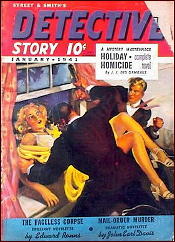
In 1943 Street & Smith changed the format of their entire pulp line of magazines from the standard pulp size of 7×10 inches to the smaller digest size. The paper shortages during WW II probably drove this decision. Then the publishers saw that the future looked bleak for pulps and killed every digest title except for Astounding.
But to get back to Daisy Bacon, she was the guiding force behind Love Story for two decades and then she took over Detective Story and actually introduced a more hardboiled story to the sedate magazine.
Detective Story had started in 1915 and for most of the next 25 years steered clear of the hardboiled type of story. But Daisy managed to get some of the Black Mask writers to write for her, for instance Roger Torrey and William Campbell Gault. Fred Brown also. I cover the history and many of the authors of Detective Story in an article which can be seen here on the Mystery*File blog.
When I say Love Story was the best of the love pulps, I’m speaking compared to each other. Since I try to collect every fiction magazine under the sun, I made an attempt, more than once, to read Love Story and some of the competition.
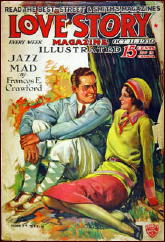
I would not advise anyone to try this experiment. Despite being the best sellers among all the pulps, the love genre was very restrictive to say the least. The young ladies and teenage girls of the 20’s, 30’s, and 40’s, only wanted to read the same formula over and over, and the love pulps gave it to them, over and over.
I’m speaking of the girl meets boy, they have some problems, and everything is resolved at the end. Ranch Romances was different from the others, but I see it as mainly a western title with some romance elements.
The love genre may have been the big sellers among pulps (and even slicks since the readership was mostly women), but nowadays collectors mainly ignore them and copies can be had very cheaply. I can count very few people who collect them.
When I bid on some copies at a recent pulp convention, several of my collector friends burst out laughing or were just stunned speechless. I could only explain my seemingly insane actions as an attempt to collect something new, since I’ve collected everything else.
Previously in this series: The FRANK M. ROBINSON Collection Auction.
Thu 15 Mar 2012
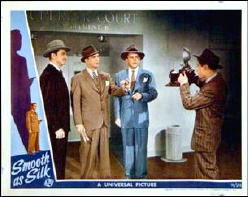
SMOOTH AS SILK. Universal Pictures, 1946. Kent Taylor, Virginia Grey, Milburn Stone, John Litel, Jane Adams, Danny Morton, Charles Trowbridge, Theresa Harris. Remake of the film A Notorious Gentleman (1935). Director: Charles Barton.
I don’t know, but if you were to ask me, the movie theaters in the US during 1946 and 1947 were filled with an abundance of crime films just like this one, filmed in black-and-white and on a budget and therefore considered by many to be “noir†looking back today.
But not by me, not really, not in this case. There’s no sense of “doom†nor “fate†in Smooth As Silk, only a whole lot of crooked activity going on by people that ought to have known better, but of course they don’t, starting with Kent Taylor’s character, a lawyer you might even call shady, simply because he can get a rich man’s nephew, a drunken playboy, acquitted from a charge of manslaughter, simply by coming up with a couple of mighty convenient witnesses.

Or maybe it is noir, since his success in the courtroom does not carry over to his love life, as the uncle (aka the rich man) repudiates his side of deal and refuses to consider Taylor’s girl friend (Virginia Grey) for the part he promised to do so for her. Whereupon the girl friend’s true colors come out, since she really does want the part and decides to make a play on her own, or make that two plays, and either way, no pun intended.
Things turn sour for him, in other words, and quickly. When the rich uncle is found murdered, there are several ways the D.A. (played by Milburn Stone, who is also making a play for the would-be actress’s kid sister, Jane Adams) can decide to play the investigation, and that goes for the killer as well. The title of the movies refers, I believe, to Kent Taylor’s character, but as slick as he is, he can’t find a way out of this one.
As you can see, I’m sure, there is a lot of plot to this story, just over 60 minutes long. There’s no depth to the characters, needless to say, but it’s still a lot of fun to watch, should you ever come across it, wherever your travels may take you.
Wed 14 Mar 2012
REVIEWED BY DAN STUMPF:

THE BIG KNIFE. United Artists, 1955. Jack Palance, Ida Lupino, Wendell Corey, Jean Hagen, Rod Steiger, Ilka Chase, Everett Sloane, Miss Shelley Winters. Based on a play by Clifford Odets. Director: Robert Aldrich.
[This review follows that of director Robert Aldrich’s The Last Sunset, which you may find here.] Too bad Aldrich couldn’t have worked similar magic with The Big Knife because he had all the elements: a corrosive play by Clifford Odets, edgy camerawork, and an off-beat cast: Rod Steiger; Ida Lupino, Wendell Core, Shelley Winters, Everett Sloane and Jean Hagen, all headed up by Jack Palance as Charley Castle, a talented actor (something of a stretch) who wants out of his contract and on to better roles.
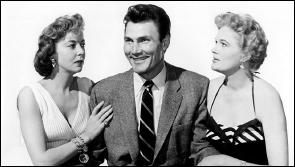
To be fair, The Big Knife has some nice stuff in it. There’s a neat dichotomy in Castle’s character: pampered and polished on the outside but inwardly rotting away.
Rod Steiger is engagingly hammy, played off against the effortless ease of Sloane and Corey, but someone let the women go w-a-y over the top, and three really talented actresses come off as little more than caricatures.

And then there’s the pace — or rather there isn’t. Knife is the kind of classic tragedy that needs fatalistic momentum; we should see Charley Castle’s destiny come careening at him in the course of a single day, like Oedipus.
Instead, director Aldrich and adapter James Poe open Odets’ play out and let it meander around, a fatal mistake with material like this. It weakens the concentration a drama needs with characters like these, and we come away wondering who to really care about.
Oddly, the one memorable characterization in the whole thing is Wendell Corey — never the most electrifying of actors — as lethal press agent “Smiley” Coy. When Smiley pours himself a drink and talks casually of killing off Shelley Winters you get a real chill. Which may be part of the problem: any movie where Wendell Corey is scarier than Jack Palance has its priorities twisted.
Wed 14 Mar 2012
Posted by Steve under
Reviews[14] Comments
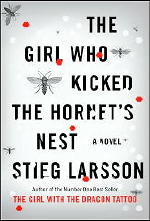
STIEG LARSSON – The Girl Who Kicked the Hornet’s Nest. Alfred A. Knopf, hardcover, May 2010. Vintage, trade paperback/mass market paperback, February 2012.
It was a long wait, nearly eighteen months since I read The Girl Who Played with Fire, the second book in the Lisbeth Salander series, and I wasn’t sure how quickly I’d get up to speed on this one – which finally came out in paperback only late last month – beginning as it does exactly where the previous one left off, with Salander being flown into a hospital after being shot in the head and buried alive at the end of the other one.

Or was it the other way around? Not that it makes a bit of difference as far as the situation she’s in.
It should come as no surprise that she survives, but she does spend most of Hornet’s Nest recovering – and preparing herself for the criminal trial she faces as soon as she’s released, along with the threat of being returned to a mental institution and the “care†of psychologist Dr. Peter Teleborian, whom she well knows as being responsible for her previous confinement.
She didn’t give in then, and she doesn’t give in now. She also has the unwanted (but not unneeded) help of journalist Mikael Blomkvist and his sister, attorney Annika Giannini. There is, in fact, an entire cadre of friends she has, some she knows about, others whom she doesn’t. But without a will of iron, she’d have been crushed long ago.

The hornet’s nest that’s referred to in the title is the huge scandal that will erupt when her side of the story is told, one that goes to the highest echelon of the Swedish government and the biggest scandal in the country’s history. Worse than Watergate in the US? Perhaps.
I don’t suppose that anything I may say will persuade you to read this book or not. If you read and enjoyed the first two books in the series, you will do as I did and start reading this one as soon as you come home from the store with it.
If you found the first two books lacking and didn’t finish them, there’s no sense your reading this one. If you haven’t even started the first one, what are you waiting for?

It may not to be your taste, and yes, there are flaws aplenty in Larsson’s writing, but on the other hand, there must be a reason for the success of this series, and I wish I could put my finger on it any more successfully than I have so far. All I can say to the naysayers, is that Larsson had the knack of telling a stories that will knock the socks right off your feet, if you allow it.
Book three in the series is well over 800 pages long in paperback, and it took me two weeks of reading 30 to 50 pages a night – until I came to the last 250 pages, which I read in a very short two hour period without even getting up to stretch. This book is wicked good, the most entertaining book I’ve read in two or three years, and even more, (almost) all of the various threads of the plot are tied up very nicely at the end. Bravo!
Tue 13 Mar 2012
IT’S ABOUT CRIME, by Marvin Lachman
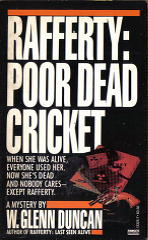
W. GLENN DUNCAN – Rafferty: Poor Dead Cricket. Gold Medal, paperback original, 1988.
Poor Dead Cricket is the third in a series about Rafferty, a Dallas private eye. Having propounded many of Lachman’s Laws myself, including the first, “Never read a book with a Swastika on the cover,” which Jon Breen once quoted in EQMM, I was glad to see that Duncan thinks similarly, and he gives many of Rafferty’s Rules, such as (#39) “Smiting the wicked sounds biblical, but mostly it’s just good clean fun.”
So is this book, about a decent, albeit wise-cracking detective who gets involved in an environmental case similar to the one involving Karen Silkwood. Rafferty does an excellent job in reconstructing the character of Cricket Dawes, who is killed before the book begins, and he sorts out the good and bad people while nicely imparting the flavor of Texas and its speech.
— Reprinted from
The MYSTERY FANcier,
Vol. 11, No. 1, Winter 1989.
The Rafferty series —
Rafferty’s Rules (1987) Film: Cinepix, 1992, as Snake Eater III: His Law.
Last Seen Alive (1987)
Poor Dead Cricket (1988)
Wrong Place, Wrong Time (1989)
Cannon’s Mouth (1990)
Fatal Sisters (1990) [Winner, Shamus award, Best Paperback Original, 1991]
Some of Rafferty’s Rules are listed here on the Thrilling Detective website. Here are a couple of good ones:
11. To feel really dumb, be a smart ass once too often.
16. When you can’t tell the bad guys from the good guys, it’s time to get the hell out.
« Previous Page — Next Page »











